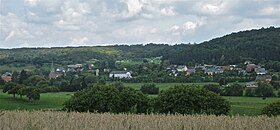| This article needs additional citations for verification. Please help improve this article by adding citations to reliable sources. Unsourced material may be challenged and removed. Find sources: "Guttland" – news · newspapers · books · scholar · JSTOR (November 2024) (Learn how and when to remove this message) |

The Guttland (German pronunciation: [ˈɡuːtˌlant]; French: Bon Pays, French pronunciation: [bɔ̃ pei]) is a region covering the southern and central parts of the Grand Duchy of Luxembourg. The Guttland (literally "Good Land") covers 68% of the territory of Luxembourg; to the north of Gutland lies the Éislek, which covers the remaining 32% of the Grand Duchy. To the east, the Luxembourgish Guttland adjoins the Bitburger Gutland [de] of Germany.
The Guttland is not an homogeneous region, and includes five main sub-regions: the Valley of the Seven Castles, Little Switzerland, the Luxembourg plateau, the Moselle Valley, and the Red Lands. Despite its variety, the Guttland does have general geographic characteristics, both physical and human, that separate it from the Éislek.
Unlike the sparsely populated Éislek, the Guttland is relatively urbanised. Whereas the Éislek has only one town with a population larger than 2,000 people, the Guttland has four cities with a population largely above 20,000 (Luxembourg City/Lëtzebuerg, Esch-sur-Alzette/Esch-Uelzecht, Differdange/Déifferdang and Dudelange/Diddeleng). However, the Guttland's urban areas are mostly congregated in the cantons of Esch-sur-Alzette (in Luxembourgish: Esch op der Uelzecht), Luxembourg (Lëtzebuerg), Capellen (same in Luxembourgish) and Mersch (Miersch), whereas some other parts of the Guttland (cantons of Redange/Réiden, Echternach/Iechternach, Grevenmacher/Gréiwemaacher and Remich/Réimech) are almost as sparsely populated as the Éislek region.
The Guttland has a lower altitude above sea level and a flatter landscape than the Éislek. Geologically, the Guttland is predominantly a large Jurassic-Triassic sandstone formation, part of the Lorrainian system; the Éislek is predominantly Devonian schist and quartz. Both are wooded, but the Éislek's forests are more numerous and thicker, a testament to the slower pace of human development in the Éislek. Most of the Guttland is fertile agricultural territory - hence the name.
References
- ^ "Luxembourg's territory". luxembourg.public.lu. Retrieved 21 November 2024.
49°42′N 6°12′E / 49.7°N 6.2°E / 49.7; 6.2
Categories: